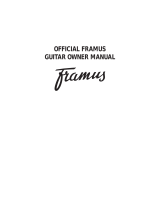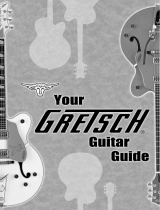
OWNER’S MANUAL
FOR FENDER® GUITARS

Si necesita acceder a los manuales de instrucciones de las guitarras en Español,
visite nuestra página web http://www.fender.com/support
Vous trouverez le mode d’emploi des guitares Fender® en français sur le site
Internet http://www.fender.com/support
Il manuale d’uso delle Chitarre Fender in Italiano è disponibile nel nostro sito web
http://www.fender.com/support
Das Fender Bedienungshandbuch für Gitarren in Deutsch, nden Sie auf unserer
Website http://www.fender.com/support
Se desejar ler o manual do proprietário Fender para guitarras em português, por
favor, visite nosso website em http://www.fender.com/support
日本語のギター用 Fender オーナーズ・マニュアルは、弊社のウェブサイト
http://www.fender.com/support をご参照ください。
Languages
1

2

Congrats on your new Fender electric guitar!
You’re in good company, by the way—the world’s guitarists—the greats and
the unsung heroes alike—have made music on instruments just like yours
for more than half a century now. Indeed, the sound of Fender is the sound of
modern music, and we welcome you to the family …
Whether you have the green hands of a newcomer or the sure grip of an
experienced player, this manual will help you out by de-mystifying things like
tuning up, changing strings, adjusting this and intonating that.
This manual will show you how to take care of your guitar for years to come, plain
and simple. Believe us, it ain’t rocket surgery, and you’ll find that much of it is
easy and even fun.
Plus, while we’re at it, we’ll tell you a lot of interesting things about Fender
along the way. So congratulations again, and let’s get right to it …
Guitars are cool.
3
History

4

18
Your new guitar’s DNA holds more than half a century of musical history.
Fender was founded in 1946 by Clarence Leonidas “Leo” Fender, a Southern California
inventor and businessman with a air for electronics. He started the company in his small
radio repair shop in Fullerton, California, building solid ampliers and simple lap steel
guitars, which were popular with western swing bands of the era. Modest beginnings, to be
sure. And rock ‘n’ roll was still a decade away.
Long story short, Leo and his staff soon embarked on an extraordinary
creative streak that began in 1950 with the world’s rst solid-body
Spanish style electric guitar, the Telecaster® (and its single-pickup
version, the Esquire®). Fender followed in 1951 with the world’s
rst commercially successful solid body electric
bass guitar, the Precision Bass®, and its
companion Bassman® amp. The Twin Amp®
appeared in 1952.
Since 1946 …
5
History

In 1954, Fender® unveiled perhaps the most popular and inuential
electric guitar ever—the Stratocaster®. Within a decade, some of
rock’s greatest artists would start wringing unbelievable sounds
never envisioned by Fender designers from this particular
model. Other classics followed—the Jazzmaster® guitar
(1958), the Jazz Bass® (1960) the Jaguar® guitar (1962),
and more great amps. By the time it was sold to CBS in
1965, Fender had grown from a edgling California guitar
maker to an industry leader with a stable of acclaimed
instruments and ampliers that transformed music
worldwide.
After CBS, the modern-era Fender was launched in the
mid-1980s, and today Fender is bigger and better than ever. It’s pretty cool, really—that a company with such
a great rock ‘n’ roll past keeps reinventing itself as a thoroughly modern industry leader that continues to
innovate straight into the great rock ‘n’ roll future.
That word—innovate—says it all. Fender was innovative
right from the very start in the 1940s and has stayed that
way ever since, right through to the 2000s. That’s why,
in the hands of everyone from hobbyists to the world’s
greatest guitarists, more popular music has been made
in the past 50 years with Fender than any other electric
instrument.
6
History

2000+
Fender continues to innovate into the
future
1946
Fender founded by
Clarence Leonidas
“Leo” Fender
1954
Stratocaster®
unveiled
1960
Jazz Bass®
created
1965
Fender sold
to CBS
1951
Precision Bass®
and
Bassman® amp
created
1952
The Twin Amp®
created
1950
Telecaster®
and
Esquire®
created
1958
Jazzmaster® quitar
created
mid-1980s
modern-era Fender
launched
1962
Jaguar® quitar
created
Timeline
7
History

8

9

Features
Specs
Controls &
For more detailed info on the features and specifications of your
specific guitar model, visit the “Products” section of www.fender.
com, where each individual guitar listing has a “Specs” link that’ll
give you an easy-to-read list.
For wiring diagrams, switch/control function diagrams and parts lists
for your specific model, visit the “Support” section of www.fender.
com, where the “Wiring Diagrams/Parts Lists” link will take you to
info on more than 250 Fender instrument models.
You can always contact us directly, too, to get this info by mail,
e-mail or telephone:
Attn: Consumer Relations
Fender Musical Instruments Corp.
8860 East Chaparral Road, Suite 100
Scottsdale, Ariz. 85250-2610
480.596.7195
10
Info

11

12

Your guitar is solidly built with the best materials and craftsmanship. As part of its final assembly, we’ve
hand-adjusted it and set it up to Fender factory specs, which give you the best possible playing action.
Like all instruments made of wood, however, your guitar may have experienced changes brought on by
exposure to different temperatures and humidity levels. This happens naturally with time and changes
in your guitar’s actual geographic location. In any case, when you receive it, the condition of the playing
action can be affected by:
• Amount of time between final assembly and shipping from Fender.
• Amount of time between shipping from Fender and arrival at shipping destination.
• Method of shipment—e.g., trucking, airfreight, submarine, llama, etc.
• Climate conditions during shipping.
• Climate conditions at shipping destination.
• Amount of time in stock at dealer before purchase.
• Whether or not the dealer has performed its own product setup on the instrument.
A Word About Factory Specs and Setup …
13
Info

Important note!
Your guitar has many adjustment points that let you compensate for changes that might
happen between final assembly and when you received it. If the action is higher or lower
than you prefer, for example, this manual describes how to set up, adjust and maintain
your guitar so that its playing condition is optimal for you. Of course, if you’d rather not
mess with it yourself—which is perfectly OK—you can always take your guitar to an
Authorized Fender Service Center.
Initial standard setup and adjustment of an instrument and its parts at time of purchase
are considered normal dealer product preparation and are not covered by the Fender
warranty. On receipt and acceptance of the instrument, the consumer assumes all
responsibility for setup, adjustment and maintenance.
Other important note!
When you first get your guitar, don’t be alarmed if the playing action is no longer set to factory
specs! Like we said, it’s natural for a guitar’s setup to change due to the factors just listed. Stay
calm and read on …
14
Info

strap
button
guitar
body
pickups
bridge
bridge
saddle
lower
bout
upper
bout
output
jack
volume
control knob
pickguard
tremolo arm
pickup
selector switch
tone
control knobs
Whether you know the names of all the parts or not, anatomical charts are
always cool. Here’s the basic anatomy of an electric guitar:
Anatomy 101
15
Anatomy

headstock
string
tree
tremolo cavity
(reverse side of guitar)
truss rod
strap button
nut
fret ngerboard
tuning keys
12th fret
marker/inlay
Anatomy 101
16
Anatomy

TYPES OF GUITARS
Telecaster®
Esquire®
Stratocaster®
Jazzmaster®
Jaguar®
Mustang®
17
Info

• Set of automotive feeler gauges (.002-.025)
• 6” ruler (with 1/64” increments) and tape measure
• Set of Allen wrenches
• Phillips head screwdriver
• Electronic tuner
• Wire cutters
• String winder
• Light machine oil (3-in-1, model train or gun oil)
• Polish and cloth
• Capo
Great Electric Guitar Setup
To put your guitar in tip-top playing shape, follow the five easy steps presented here. First things first,
though—you’re gonna need the right tools:
Note: The following factory specications are median specs, and are meant only to guide you. They should not be taken as hard and fast rules.
If you prefer your action a little higher or lower, change it as you like, but be aware that higher action will be more difcult to play and lower action
may result in excessive fret buzz, depending on your technique, or style of play.
18
Set-up

There is no better, faster or easier way to reinvigorate the sound of your guitar
than simply changing the strings. It’s easy to tell when strings are old, worn
or dirty—they sound dull and lifeless, and they feel rough when you run your
fingers along them. Changing strings isn’t difficult, but there are several ways to
do it depending on what Fender guitar model you have.
Strings attach to the body at the bridge and to the headstock at the tuning
machines. Since various Fender guitar models use a variety of bridges and
tuning machines, different instruments call for different string replacement
instructions too varied and lengthy to list in a small booklet like this one.
Therefore, for the specific string changing instructions for your Fender guitar,
we’re going to steer you online to the “Support” section of www.fender.com.
There you can use the “Setup Guide” link to find specific and easy-to-follow
instructions for Telecaster®, Stratocaster®, Jazzmaster®, Jaguar® and other
Fender guitars with various bridge and tuning machine types.
1. Changing Strings
19
Set-up
Page is loading ...
Page is loading ...
Page is loading ...
Page is loading ...
Page is loading ...
Page is loading ...
Page is loading ...
Page is loading ...
Page is loading ...
Page is loading ...
Page is loading ...
Page is loading ...
-
 1
1
-
 2
2
-
 3
3
-
 4
4
-
 5
5
-
 6
6
-
 7
7
-
 8
8
-
 9
9
-
 10
10
-
 11
11
-
 12
12
-
 13
13
-
 14
14
-
 15
15
-
 16
16
-
 17
17
-
 18
18
-
 19
19
-
 20
20
-
 21
21
-
 22
22
-
 23
23
-
 24
24
-
 25
25
-
 26
26
-
 27
27
-
 28
28
-
 29
29
-
 30
30
-
 31
31
-
 32
32
Fender Eric Clapton Stratocaster Owner's manual
- Category
- Guitars
- Type
- Owner's manual
Ask a question and I''ll find the answer in the document
Finding information in a document is now easier with AI
Related papers
-
Fender 2011 Owner's Manual for Fender Guitars Owner's manual
-
Fender Affinity Series™ Stratocaster® HH User manual
-
Fender Lone Star Stratocaster User manual
-
Fender Special Design Humbucking Owner's manual
-
Fender Player Stratocaster Maple Neck Electric Guitar User manual
-
Fender ERIC CLAPTON STRATOCASTER 011-7702 User manual
-
Fender 101 Owner's manual
-
Fender Reissue '62 Custom Telecaster (Japan 1986) Owner's manual
-
Fender ARTist series User manual
Other documents
-
Yamaha ZV54671 Owner's manual
-
Grizzly H8068 User manual
-
Grizzly Musical Instrument H8070 User manual
-
Grizzly Guitar BL8551 User manual
-
Kodak ESP 7200 - START HERE Install Manual
-
 Variax JTV-69 Pilot's Handbook Manual
Variax JTV-69 Pilot's Handbook Manual
-
 Framus Hollywood Owner's manual
Framus Hollywood Owner's manual
-
 Gretsch Guitar User manual
Gretsch Guitar User manual
-
East West Sounds Ministry of Rock 2 User manual
-
Carson 510001459 Operating instructions


































